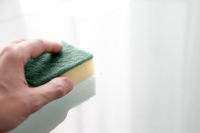Preparing the Floor for Microcement Application
Before diving into the application of microcement, it's crucial to ensure that the floor surface is adequately prepared. Start by thoroughly cleaning the floor to remove any dust, grease, or debris. This step is essential because any contaminants can affect the adhesion of the microcement. Use a vacuum cleaner and a damp mop to ensure the surface is spotless. If there are any stubborn stains or residues, consider using a mild detergent or a specialised floor cleaner. Next, inspect the floor for any cracks or uneven areas. These imperfections need to be addressed before applying microcement. Use a suitable filler to repair any cracks and sand down any uneven spots to create a smooth, level surface. This will not only improve the final appearance but also ensure the durability of the microcement layer. If the floor is particularly porous or has been previously treated, applying a primer can enhance the adhesion of the microcement, providing a more robust and long-lasting finish. Finally, ensure the floor is completely dry before proceeding. Any residual moisture can compromise the microcement application, leading to potential issues down the line. By taking these preparatory steps seriously, you'll set the stage for a successful and professional-looking microcement floor that stands the test of time.
Preparing the Floor for Microcement Application
Before diving into the application of microcement, it's crucial to prepare the floor meticulously. Start by clearing the area; remove all furniture and obstacles to ensure you have a clean workspace. Next, clean the surface thoroughly by sweeping and mopping to eliminate dust and debris. This step is vital for ensuring that the microcement adheres properly. If there are any cracks or holes, make sure to repair any damage using a suitable filler. This will create a smooth and even base, which is essential for a flawless finish. Once the surface is clean and repaired, the next step is to sand the floor. Sanding ensures that the floor is smooth and even, which is critical for the microcement application. After sanding, apply a primer suitable for microcement. This primer will enhance the adhesion of the microcement to the floor, ensuring a durable and long-lasting finish. Experts' advice is to follow the manufacturer's instructions for the best results.
Mixing Microcement for Optimal Consistency
Achieving the right consistency when mixing microcement is crucial for a successful application. Start by following the manufacturer's guidelines for the correct ratio of microcement to water. Use a mechanical mixer to blend the components until you achieve a smooth, lump-free mixture. The consistency should be similar to that of thick cream, allowing for easy application while maintaining the strength and durability of the microcement. Experts' advice is to mix in small batches to prevent the mixture from drying out before application.
Applying the First Coat of Microcement
Before diving into the application, it's crucial to gather all necessary materials: microcement powder, water, and mixing tools. Following the manufacturer’s instructions is non-negotiable; ensure you check the recommended water-to-powder ratio. This step is often overlooked, but it’s the foundation of a successful application. Once you have your materials, use a mechanical mixer to blend the microcement thoroughly. This ensures a consistent mixture that is smooth and lump-free. Experts advise letting the mixture rest for a few minutes before application to achieve the best results. This resting period allows the components to fully integrate, making the application process smoother and more effective. When applying the first coat, ensure the mixture's consistency is just right. It should be smooth and easy to spread. This initial layer sets the stage for the subsequent coats, so take your time to get it right. Remember, the key to a flawless finish lies in the preparation and the quality of the first coat.
Sanding and Applying Subsequent Coats
When it comes to applying microcement on floors, the devil is in the details. First, grab a trowel and spread the microcement evenly across the floor. It's crucial to work in sections; start from one corner and move systematically to ensure you cover every inch. Aim for a thin, even layer, ideally around 1-2mm. This is where precision matters—use the trowel to eliminate any air bubbles or imperfections. Once you're satisfied with the smoothness, let the first coat dry completely, which usually takes about 24 hours. After the initial coat has dried, it's time for sanding and applying subsequent coats. Sand the surface lightly to remove any minor imperfections and prepare it for the next layer. This step is essential for achieving a flawless finish. Apply the next coat of microcement, again aiming for a thin, even layer. Repeat the process of smoothing and drying. Depending on the desired finish, you may need to apply multiple coats, always ensuring each layer is perfectly smooth and fully dried before moving on to the next.
Sealing and Finishing the Microcement Floor
Once you've applied the microcement, it's crucial to focus on the sealing and finishing process to ensure a durable and aesthetically pleasing result. Start by sanding the first coat using fine-grit sandpaper. This step is essential to achieve a smooth surface. After sanding, make sure to clean the surface thoroughly. Use a vacuum or a damp cloth to remove all dust and debris, as any remaining particles can affect the adhesion of subsequent layers.
Next, apply additional coats of microcement. Typically, you will need 2-3 more coats to achieve the desired thickness and finish. Remember to sand between coats to ensure each layer is smooth before adding the next. This not only improves the texture but also enhances the overall durability of the floor. After applying the final coat, perform a final sanding to achieve a perfectly smooth finish. This meticulous approach will result in a stunning, long-lasting microcement floor.
Sealing Your Microcement Floor: A Comprehensive Guide
After you've meticulously applied your microcement, the next crucial step is to seal it properly. This ensures durability and longevity. Here's a detailed guide to help you through the process:
- Choose a sealer: The first step is to select a sealer that is compatible with microcement. This is essential for achieving the best results and ensuring the longevity of your floor.
- Apply the sealer: Use a roller or brush to apply the sealer evenly. Make sure to cover the entire surface to avoid any missed spots. An even application is key to a professional finish.
- Allow to dry: Follow the manufacturer’s drying time recommendations. This step is crucial as it ensures that the sealer sets properly, providing maximum protection.
- Apply additional layers: For extra protection, it's advisable to apply 2-3 coats of sealer. This will enhance the durability and resistance of your microcement floor.
- Final inspection: Once the sealer has dried, conduct a thorough inspection. Check for any missed spots or imperfections and touch up as needed to ensure a flawless finish.
By following these steps, you can ensure that your microcement floor is not only aesthetically pleasing but also durable and long-lasting. Proper sealing is the key to maintaining the beauty and functionality of your floor for years to come.















